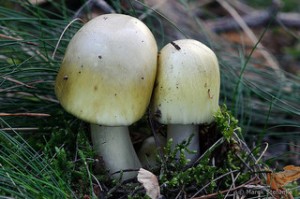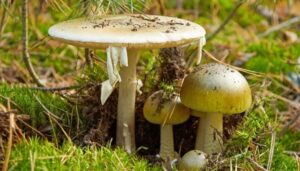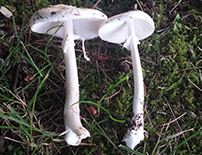Amanita phalloides, the death cap mushroom The mushrooms have a sweet odor (like honey) and are attractive to some dogs (whose owners report they actually seek them out to eat them). They are really non little white mushrooms. The toxic effects appear about 6-36 hours after the mushrooms are eaten, and once signs are seen the toxicity is poorly responsive to treatment (we try a lot of things to support the animal, but if enough mushrooms were eaten it will be fatal despite the treatment). If someone suspects their dog may have eaten a mushroom, the best treatment is to take the dog immediately to a vet or emergency clinic and have them induce vomiting and give activated charcoal. The mushroom toxin is absorbed fairly rapidly, but the damage to the liver can take hours before it is clinically apparent. Don’t waste time trying to figure out if the mushroom is toxic as speed in removing the mushroom from the digestive system is the most important thing in my experience.Here is a link with some pictures https://wikipedia.org/wiki/amanita_phalloides
Although most SF/local mushrooms are not poisonous, and those that are usually cause only digestive upset (perhaps causing someone to wish they would die), Death Caps (Amanita phalloides) are aptly named. After an initial digestive upset death caps prevent liver cells from regenerating. Within a few days after ingestion there are no new liver cells to replace the old ones, and liver failure occurs. The below message describes death caps as “little white mushrooms.” Note: They might look like that in the early stages, but mature mushrooms can grow quite large (check yahoo group for photo of mushroom I’m holding in hand) and they have a slight metallic, greenish look. Check out the wikipedia link for photos of death caps in various stages. I have seen death caps south of SF and in the east bay. There might be some in SF. The common “white mushrooms” I’ve seen in SF, e.g. growing in lawns, are not death caps (various Agaricus–see photo). Death Caps have WHITE GILLS (e.g. the radiating blades on the underside of the cap), while most of the “lawn” mushroom have brown gills. At Fort Funston beneath the trees, I’ve spotted white-gilled mushrooms, but they have shaggy scales on the cap (see photo). Not death caps. Possibly Lepiota rachodes. Don’t take a chance w/mushroom, especially death caps. Supervise your dog.







